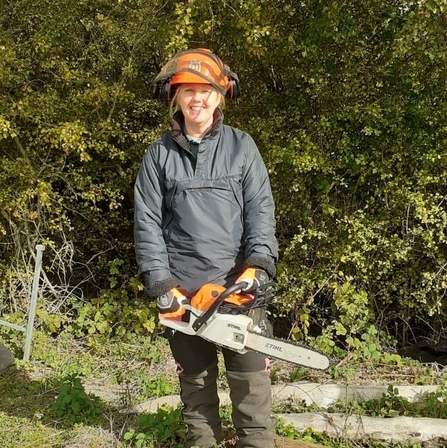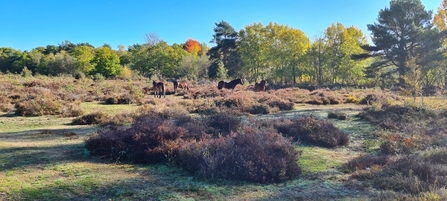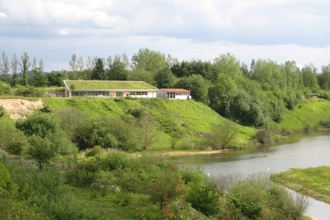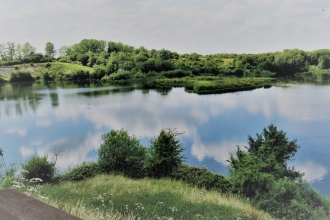
Chrystal Thompson

Chrystal Thompson
Today is the first day of my traineeship and I cannot wait! Having served in the military for the last 26 and a half years I wanted a new challenge. My first step towards the traineeship was an interview, something that I hadn’t taken part in for over 27 years, so I was very excited when I learned that I had been successful and was offered the placement.
My placement was located at Estovers situated on Greenham and Crookham Commons, Newbury. This used to be an old American Air Force base that was used to store nuclear missiles during the Cold War period. The land has now been reclaimed and turned into common land for all to enjoy.
On arrival at Estovers, I was briefed on Health and Safety policies, my hours, and days of work, along with being issued my PPE, and a set of keys, and signed all the relevant paperwork. I was then told about what I was expected to learn over the course of the year, and it all sounded very exciting!
The first part of my training was to assess my driving experience. I had to drive the Ford Ranger and carry out a 4x4 driving assessment over various terrains on the Common. Thankfully my previous experience paid off and I was signed off for vehicle driving straight away.

Snelsmore Common. Photo by Chrystal Thompson
Every fortnight we carried out maintenance checks of all the vehicles, including the First Aid boxes which were checked every three months. Checking that all fluid levels were correct and topped up where necessary, and that the tyre pressures and bulbs were all working. Inside the vehicles was a basic tool kit with a few extra tools for any small jobs we came across whilst out on the sites. I was responsible for checking all tools were present and in good working order.
For part of my learning, we carried out butterfly transects, grazing impact, and bird surveys. The butterfly and grazing surveys were both undertaken on Greenham Common. I was looking forward to carrying out the surveys as it would help me to understand the collection and recording methods of data that we have previously used at university.
Firstly we checked and noted the temperature, time, and wind conditions were correct for the survey. By using GPS we walked to each point of the transect that was marked out. On my first survey, we didn’t record any butterflies, this may have been due to it being still quite early in the season. Over the next few months, I undertook the transect every few weeks, spotting many varieties that were popular in the area.
Using the Wild ID guide, I was able to identify the following species. Graylings (Hipparchia semele), meadow browns (Maniola jurtina), commas (Polygonia c-album), large whites (Pieris brassicae), orange-tips (Anthocharis cardamines), brimstones (Gonepteryx rhamni), red admirals (Vanessa atalanta) and marbled whites (Melanargia galathea). They were amazing to see and there were definitely a few that I had never spotted before.

A transect quadrat for measuring the impact of grazing at Greenham Common. Photo by Chrystal Thompson
The grazing survey takes place once a month and is marked out over Greenham and Crookham Common by using GPS references set by the Ecology team, this was so that each 1m² quadrat was placed in the same location, each time. There were also three enclosures fenced off to use as a control area.
Following the GPS directions, I would place the quadrat down at the location, and for the data collection, I needed to measure the height of the sward and record the percentage of herbs and the herbage in flower. By using a ruler and lowering my hand down to the top of the height of the sward and I recorded the height in cm. For the percentage of herbage and flowering herbage, I calculated the percentage of herbage and flowering herbage within. Every tenth square was numbered and photographed and emailed to the ecology team to check for accuracy.
At the end of July, we carried out a Rapid Assessment at Hurley Chalk Pit. We were joined by another team from within the Trust. Using the same survey method as before, but this time each quadrat was three metres apart, allowing for more of the area to be covered in one day. This survey is completed every three years and the data that was recorded was fed back to the ecology team so that they can make recommendations on how to manage the habitat.
In the summer months on a Friday evening I took part in nightjar surveying. Nightjars (Caprimulgus europaeus) are migratory birds from Africa, arriving around April - May before heading back South in September. They make their nests in simple scrapes on the ground and prefer lowland heathland and heather moors to lie low in. They make a distinctive churring sound after dark and will hunt for insects at night. They will stay motionless during the day.

Nightjars nest on the ground and are incredibly well-camouflaged. Photo © David Tipling/2020VISION
The data needed to be recorded for the survey were numbers seen, and in what location. For me this was an amazing experience having never heard or seen a nightjar. The noise they made was unique, and unlike anything that I had heard before.
From March through to June, I took part in the Nest Record Scheme which is run in conjunction with the British Trust for Ornithology’s methods of recording. Using their information sheets to record the data we set about checking the bird boxes positioned in the trees. Gently lifting the lid, making sure to cause only minimal disturbance, I looked inside the box. Inside were tiny chicks, with no feathers and still with their eyes closed, they opened their mouths ready to be fed. I could have stayed there all day watching them, but I was aware of the mother close by chirping loudly, so I made a note of what I saw and replaced the lid.
On the ground, I recorded what the box contained, and the age of the chicks by using the guide provided by identifying the length of feathers or lack of them. Moving on to the rest of the bird boxes I was able to record the stages of each box, as to whether it was completely empty, a nest being built, or did the nest contain eggs or chicks. The data collected will show if the nest was successful or not.

Some of the volunteers at Thatcham Reedbeds. Photo by Chrystal Thompson
Wednesdays are our main volunteer days. I was a bit nervous at first as I had previously worked alongside the group as a volunteer myself and looked up to them for advice. However this time I would be leading the group which I found to be very daunting. On Wednesday morning I was instructed on the task for the day and assisted with the collecting and loading of all the equipment we required. It was to be a path clearance at Snelsmore Common. I was given the risk assessment to complete, and it was checked over by my mentor.
On arrival at the site, my mentor briefed the volunteers on the day’s task, and I was to deliver the risk assessment, I made sure that they all understood the risks and if they had any questions and then checked that they had all signed to say they were happy to continue.
I was first leading the team with my mentor to make sure we were both happy with how I was delivering and managing the group but after a couple of sessions, I was able to lead the group on my own. This helped me build on my confidence and knowledge of all the sites that we look after and how each task that was set would be completed. The tasks ranged from cutting brash to replacing fence posts or a step.
To help with the maintenance of the habitats, the Trust had Exmoor ponies that were kept on Greenham and Snelsmore Common throughout the year. Other sites were rotated with sheep and cattle. I never knew how stubborn cattle could be! They did not like being loaded onto the trailer and would run in different directions to where we needed them. The sheep proved to be as difficult, I had never seen sheep jump so high or implant themselves into hawthorn bushes just to get away.

Exmoor ponies at Snelsmore Common. Photo by Chrystal Thompson
We covered a variety of sites, from wooded areas with footpaths so that the public could have access. Meadows, that were left to grow over the summer before it was mown, giving the butterflies and other pollinators a chance to feed off the wildflowers that grew there.
The Nature Discovery Centre (NDC) is an educational site with a café and play area, a few large lakes that are managed by the local fishing club, and various commons where we would clear fire breaks and replace fences and fence posts. At Christmas we treated the volunteers to a festive barbecue, which is normally held in the summer but due to the fire risk over that period, we put it off until the winter months.
Part of my traineeship was to attend several courses, one of which was chainsawing. The week before the course, I received my chainsaw tool kit and was given a run-through of all the working parts, their names, and how to maintain them. I was very grateful, as it helped me to be in a better place for the course. The course ran over a week with the assessment two weeks later and was held at Meadow Farm, another Wildlife Trust site.
The first day consisted of maintenance and how the chainsaw worked, the rest of the week we practiced the various cuts we would use and the various techniques you may need should a tree act unpredictably, get hung up in another, and about tension and compression in the wood. After a week of practice felling, I was ready for my assessment in two weeks, I was quite nervous as I was unsure what kind of cuts I was going to be asked to carry out. I took my time and thought things through, and I successfully passed the course!
I built on my experience over the next few months, cutting back gorse to create a 10-metre fire break on the common, clearance of some branches of a willow tree that was beginning to encroach onto farmland, and silver birch on Snelsmore common.
Brush cutting was another vital part of my traineeship, the training for this was held in-house. I started with basic cutting on grass verges and progressed on to denser scrub such as bramble and small trees. The hardest part of brush cutting was cutting back the reeds at the reedbed. This was part of a three-year rotation to prevent encroachment from the surrounding hedges and fields and to clear causeways so that monitoring water levels in the reedbeds and other management could take place.
BBOWT staff and volunteers carrying out the annual snake's-head fritillary count at Iffley Meadows nature reserve in April 2023. Picture: Pete Hughes
Another opportunity that I had was to count the snake's-head fritillaries at Iffley Meadows, Oxford. I met up with other trainees and the ecology team and the task was to count the number of fritillaries in the meadow and record them on the datasheet. The previous data has been collected over many years and has helped to monitor the rise or decline of the species and inform the management of the site.
I attended a three-day first aid course which also covered forestry first aid. We were given instructions on treating various injuries and then given a situation to carry out role play to make sure we carried out the correct first aid procedure.
Another part of our traineeship was the environmental education trainee course at Sutton Courtenay Environmental Education Centre, Didcot. This gave us an introduction to outdoor education for children, covering the benefits and challenges of simple outdoor activities, such as blindfolded tree walks, finding different leaves, petals, bark etc to stick on bug pictures, risk assessments, how to run a pond dipping session and mini-beast hunting. I also learned how to plan and deliver my own learning session.
All trainees and new staff members were invited to attend an Introduction and welcome to BBOWT at Woolley Firs, Maidenhead. Here we met the main directors of each area and listened to their presentations on community engagement; people; finance and operations; fundraising, marketing and communications; land management and conservation strategy. In the afternoon we were invited into smaller groups to have a question-and-answer session with each one. This was very interesting for me as I didn’t realise so much more went on in the background.
Two courses I had to attend online on Zoom, one was about how to use social media to the advantage of the Trust and to be able to promote positivity about the issues they work on. I also had to attend an online driver awareness course. This helped me to be more aware of driving situations and refresh of the Highway Code.
As I was now responsible for the weekly volunteer group, I attended a volunteer leadership course. This went over things regarding leadership management, some of which I was already aware of and was able to contribute my views in a positive manner.

BBOWT staff at all-team meeting in September 2022. Picture: Pete Hughes
The Wildlife Trust organised an area get-together at Marlow Rugby Club, in the morning we had three talks on future projects and where the Trust was headed, lunch was provided by an outdoor catering company which was very nice, using sustainable disposables was also a great addition. In the afternoon we carried out team-building exercises, a few people seemed reluctant to begin with but by the end of the afternoon, everyone was really enjoying it.
The last course I attended was a tools' course, which was invaluable, especially for me, however, I surprised myself in the identification test by scoring a relatively high score, I still have a lot of names and their uses to learn!
Over the course of the year, I learned so much and was also able to use a lot of transferable skills. I was surprised at how much I already knew, as coming from an entirely different background, I didn’t think I was going to be able to offer much. I have found the traineeship a huge benefit and it has enabled me to go forward and start a role as an Assistant Ranger with the National Trust.
Chrystal Thompson, past BBOWT trainee in West Berkshire
BBOWT relies on hundreds of volunteers to help us create more nature everywhere, for everyone. We have opportunities on nature reserves, at our education and visitor centres, at events and in our offices. See if there's an opportunity near you.

Our Visitor Welcome Volunteers are the friendly first point of contact for everyone visiting the visitor centre on our spectacular…

As a Retail and Information Volunteer you'll be the friendly face of the visitor centre, inspiring people to deepen their…

Turn your practical skills into purpose at College Lake!
The Tools Maintenance Volunteer will work with the South Bucks Reserves…
We are looking for keen and enthusiastic people to help carry out a wide range of practical tasks to maintain and enhance the habitats…

An opportunity to carry out practical conservation tasks around this nature reserve near Wendover. This friendly group meets on the…

Get Your Hands Dirty for Nature at Moor Copse!
Do you crave fresh air and a chance to get seriously stuck in? Join the BBOWT Moor…